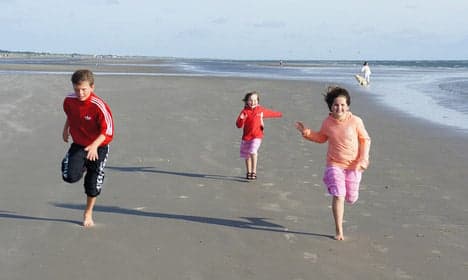Danish kids among the fittest in the world: study

In a study comparing the fitness levels of children in 50 different nations, Danish kids came near the very top.
Denmark ranked sixth in a study conducted by the University of North Dakota (UND) and the Children’s Hospital of Eastern Ontario that examined the aerobic fitness levels of children and youth. The study focused on the so-called beep test, a 20-metre shuttle run that is among the most commonly used international fitness indicators.
Some 1.1 million kids between the ages of nine and 17 had their beep test results analyzed to draw conclusions about children’s fitness levels in the 50 countries examined.
“If all the kids in the world were to line up for a race, the average Danish child would finish at the front of the pack, placed sixth out of 50,” Grant Tomkinson, the senior author of the study, told The Local.
Tomkinson, an associate professor of kinesiology at the UND College of Education and Human Development, said that the children’s aerobic fitness results are “very insightful to overall population health” but acknowledged that the results don’t necessarily paint a complete picture.
“We didn’t have good international data on diet,” he said. “Because we examined between-country differences in fitness we were interested in broad socio-economic correlates. Obesity was a weak negative correlate with fitness in developed countries (fatter countries fared worse), climate was a strong positive correlate in developed countries (hotter countries fared better), and income inequality was a strong negative correlate in developed countries (more equal countries fared better).”
Denmark was topped in the list by Tanzania, Iceland, Estonia, Norway and Japan. The United States placed near the very bottom at number 47 out of 50.
Tomkinson said that the strong overall performance of Nordic countries was interesting from an American point of view “because we can always learn from countries with fit kids”.
“We know that Scandinavian countries have very good physical activity infrastructure and government strategies and investments, as does the US, but poor overall physical activity levels, also like the US, despite having better participation rates in organized sport and active transportation like cycling or walking to and from school than the US,” he told The Local.
“They are also leaner that US kids which means it is easier for them to move their body through space and run over long distances,” he added.
The results of the study, which Tomkinson said is the largest of its kind, were recently published in the British Journal of Sports Medicine.
Comments
See Also
Denmark ranked sixth in a study conducted by the University of North Dakota (UND) and the Children’s Hospital of Eastern Ontario that examined the aerobic fitness levels of children and youth. The study focused on the so-called beep test, a 20-metre shuttle run that is among the most commonly used international fitness indicators.
Some 1.1 million kids between the ages of nine and 17 had their beep test results analyzed to draw conclusions about children’s fitness levels in the 50 countries examined.
“If all the kids in the world were to line up for a race, the average Danish child would finish at the front of the pack, placed sixth out of 50,” Grant Tomkinson, the senior author of the study, told The Local.
Tomkinson, an associate professor of kinesiology at the UND College of Education and Human Development, said that the children’s aerobic fitness results are “very insightful to overall population health” but acknowledged that the results don’t necessarily paint a complete picture.
“We didn’t have good international data on diet,” he said. “Because we examined between-country differences in fitness we were interested in broad socio-economic correlates. Obesity was a weak negative correlate with fitness in developed countries (fatter countries fared worse), climate was a strong positive correlate in developed countries (hotter countries fared better), and income inequality was a strong negative correlate in developed countries (more equal countries fared better).”
Denmark was topped in the list by Tanzania, Iceland, Estonia, Norway and Japan. The United States placed near the very bottom at number 47 out of 50.
Tomkinson said that the strong overall performance of Nordic countries was interesting from an American point of view “because we can always learn from countries with fit kids”.
“We know that Scandinavian countries have very good physical activity infrastructure and government strategies and investments, as does the US, but poor overall physical activity levels, also like the US, despite having better participation rates in organized sport and active transportation like cycling or walking to and from school than the US,” he told The Local.
“They are also leaner that US kids which means it is easier for them to move their body through space and run over long distances,” he added.
The results of the study, which Tomkinson said is the largest of its kind, were recently published in the British Journal of Sports Medicine.
Join the conversation in our comments section below. Share your own views and experience and if you have a question or suggestion for our journalists then email us at [email protected].
Please keep comments civil, constructive and on topic – and make sure to read our terms of use before getting involved.
Please log in here to leave a comment.